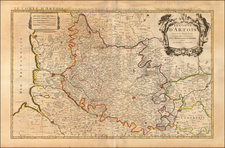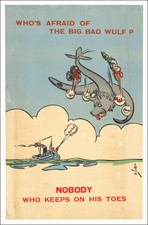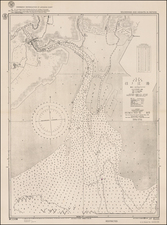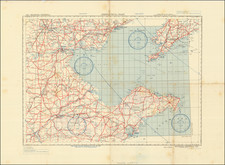Booby Traps and Minefields. The Liberation of Le Havre, One of the Last Major Conflicts in Normandy.
Heavily-annotated map of the Norman port city of Le Havre, detailing the situation in the city after the German evacuation, by Major Stockdale.
The map contains extensive annotations about the booby traps, areas marked off for civilians, and other remnants of the German attack such as tank ditches, mines, and bottle mines. The markings on the map suggest that Stockdale was involved in the post-battle cleanup efforts and was likely responsible for identifying and documenting these hazards to ensure the safety of civilians and military personnel.
The printed base map was drawn from several sources, including a 1934 map of the city from the Conservateur du Cadastre de la Ville du Havre, a 1939 map of the port from the Naval Staff, a 1936 map of Le Havre Port Autonome by Imp. M. Etaix, and intelligence information from 1942-43. Additionally, air photographs were used in the production of the plan. These sources provided detailed information about the layout of the city, including critical points such as buildings and infrastructure. The annotations by Major H. C. N. Stockdale were added to the printed map to highlight hazards and other obstacles left behind by the German forces following the battle of Le Havre.
It is unclear who Major H. C. N. Stockdale was or what his role was in the post-battle cleanup efforts. However, his detailed annotations on the map suggest that he played a crucial role in the post-war occupation of the city. His annotations show that he was a knowledgeable and experienced military officer, likely involved in intelligence gathering or engineering operations.
Major Stockdale's annotations on the map were likely intended to guide troops and civilians around these hazards and prevent accidents and casualties.
The Battle of Le Havre
The battle of Le Havre occurred in September 1944, during the Allied invasion of Normandy. The German forces, who occupied the city, resisted fiercely and inflicted significant damage on the city before their eventual defeat. The battle resulted in the destruction of much of Le Havre, and an estimated 5,000 civilians were killed or injured. Many of those who survived were left homeless, and the city's infrastructure was severely damaged.
The Germans left behind significant obstacles and hazards, such as mines and booby traps, to impede the progress of Allied forces. These hazards posed a severe risk to civilians who returned to the city after the battle. The battle of Le Havre was a critical part of the Normandy campaign during World War II. It began on September 10, 1944, when British forces launched an assault on the city, which was then occupied by German forces. The Germans had heavily fortified the city, and the battle was long and bloody, with fierce resistance from the Germans. The British forces used heavy artillery and air support to weaken the German defenses, but the fighting was intense, and the Germans held on for several days.
The importance of the battle of Le Havre lay in the fact that the city was a key port on the English Channel, and it was essential for the Allies to capture it to facilitate their advance into Germany. The capture of Le Havre allowed the Allies to establish a supply line, which was critical for the success of their campaign. The battle also served as a valuable test of the British army's ability to overcome a heavily fortified position and demonstrated the effectiveness of the Allied air and artillery support.
The experiences of the Allies in the battle of Le Havre had a significant impact on decision-making after the battle. The Germans had heavily fortified the city, and the Allied forces had to overcome significant obstacles to capture it. The battle revealed the effectiveness of the German defenses, and it was clear that the Allies needed to change their tactics to overcome these defenses. The lessons learned in the battle of Le Havre were applied to subsequent battles in the Normandy campaign, and they helped the Allies to achieve a more effective and successful strategy in their fight against the German army.














![(World War II) [Iwo Jima Aerial Reconnaissance Photograph, March 8, 1945]](https://storage.googleapis.com/raremaps/img/small/83776.jpg)
![(Second World War - Italian Propaganda Poster) i 50 Sbarchi in Gran Bretagna
[The 50 Landings in Great Britain]](https://storage.googleapis.com/raremaps/img/small/86443.jpg)
